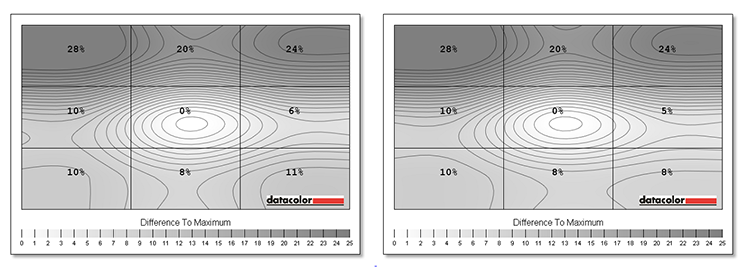Testing results II
Uncalibrated performance, left, calibrated, right
The white point is high for our liking. Reducing the brightness to zero enables the screen to show adequate blacks. The depth of colour isn't as deep as on AMVA screens, where we see a figure of <0.05. Contrast, however, is decent.
Uncalibrated performance, left, calibrated, right
There's a fair degree of luminance variation across the screen, with or without calibration, manifested by the upper portion of the screen being darker than the central point. We expect to see up to 25 per cent deviation from an IPS-type display; the Asus numbers are just outside that.
General usage
The empirical numbers show that the PG279Q excels in colour reproduction, has decent gamut coverage, but loses a mark or two in luminance and uniformity testing. The more hands-on approach indicates that colours are indeed rich and accurate. The monitor's reproduction of videos, web content and general gaming is subjectively better than the TN-based PG278Q of last year. In particular, viewing angles are much improved, colour vibrancy is better from the also-matte screen, lending to a better viewing experience. For everyday work there is no question in our minds - the IPS-like PG279Q is better than the TN-based PG278Q.
We noticed some backlight bleed in the very top-right of the screen when set to a black background. There's also some minor evidence of what is known as IPS Glow, which makes the screen look a tad bright when set to a dark background. The glow isn't obtrusive, mind, and is only perceivable when you're singularly looking out for it.
Yet scientific testing isn't evaluating the monitor in its full context. Rather, it need to be examined when playing games, preferably at high frame rates with the G-Sync or ULMB technology active.











